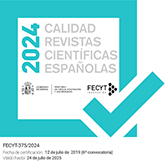La percepción del alemán multietnolectal de Zúrich: un continuo más que una categorización neta
DOI:
https://doi.org/10.3989/loquens.2020.072Palabras clave:
Multietnolectos, lenguaje juvenil, dialecto alemán de Zúrich, sociofonética, percepciónResumen
A partir del año 2000 aproximadamente se ha observado la aparición de los llamados ‘multietnolectos’ en la Suiza de habla alemana. Sin embargo, hasta el momento no existe una descripción sistemática de estas variedades lingüísticas. Los escasos estudios de percepción que se han realizado en otros países europeos se basan por lo general en la comparación de dos o más grupos preestablecidos. Este artículo investiga qué términos se utilizan para denominar el multietnolecto hablado en Zúrich y cómo un grupo adolescentes califican esta manera de hablar, adoptando, pues, un enfoque de sociolingüística perceptiva que se centra en las representaciones de locutores comunes más que de lingüistas.
En un experimento de percepción, cuarenta adolescentes escucharon breves muestras de habla producidas por 48 escolares que habían sido grabadas en dos escuelas de la ciudad de Zúrich. La tarea de los oyentes consistió en calificar a los locutores con una escala de Likert de siete puntos según cómo de multietnolectal sonaba su habla (no en absoluto – muy fuertemente). Los resultados revelan la existencia de un continuum perceptivo más que de una categorización binaria [±multietnolectal].
El mismo experimento se realizó también con ocho oyentes adultos, obteniendo una correlación muy fuerte y altamente significativa con los valores de los oyentes adolescentes. Estos resultados sugieren que en la percepción del multietnolecto alemán de Zúrich no parece existir una diferencia entre una perspectiva etic y una perspectiva emic.
Descargas
Citas
Ammon, U. (2003). Dialektschwund, Dialekt-Standard-Kontinuum, Diglossie: Drei Typen des Verhältnisses Dialekt - Standardvarietät im deutschen Sprachgebiet. In J. K. Androutsopoulos, & E. Ziegler (Eds.), "Standardfragen": Soziolinguistische Perspektiven auf Sprachgeschichte, Sprachkontakt und Sprachvariation (pp. 163-171). Peter Lang.
Anders, C. A. (2010). Die wahrnehmungsdialektologische Rekodierung von laienlinguistischem Alltagswissen. In C. A. Anders, M. Hundt, & A. Lasch (Eds.), Perceptual Dialectology: Neue Wege der Dialektologie (pp. 67-87). De Gruyter. https://doi.org/10.1515/9783110227529
Androutsopoulos, J. (2001). Ultra korregd Alder: Zur medialen Stilisierung und Popularisierung von 'Türkendeutsch'. Deutsche Sprache 4, 321-339.
Appel, R. (1999). Straattaal: De mengtaal van jongeren in Amsterdam. Toegepaste Taalwetenschap in Artikelen 62(2), 39-57. https://doi.org/10.1075/ttwia.62.04app
Auer, P. (2003). 'Türkenslang': Ein jugendsprachlicher Ethnolekt des Deutschen und seine Transformationen. In A. Häcki Buhofer (Ed.), Spracherwerb und Lebensalter (pp. 255-264). Francke.
Auer, P., & Røyneland, U. (2020). Modelling acquisition and use of dialectal, standard and multiethnolectal features in migratory contexts across Europe. Journal of Multilingual and Multicultural Development. https://doi.org/10.1080/01434632.2020.1730385
Berry, J. W. (1999). Emics and etics: A symbiotic conception. Culture & psychology 5(2), 165-171. https://doi.org/10.1177/1354067X9952004
Bodén, P. (2010). Pronunciation in Swedish multiethnolect. In P. Quist, & B. A. Svendsen (Eds.), Multilingual urban Scandinavia: New linguistic practices (pp. 65-78). Multilingual Matters. https://doi.org/10.21832/9781847693143-010
Bruno, M. (2019). Morphosyntaktische Merkmale von multiethnolektalem Zürichdeutsch. University of Zurich MA thesis.
Cheshire, J., & Fox, S. (2016). From sociolinguistic research to English language teaching. In K. P. Corrigan, & A. Mearns (Eds.), Creating and digitizing language corpora (2nd ed.) (pp. 265-290). Palgrave Macmillan. https://doi.org/10.1057/978-1-137-38645-8_10
Cheshire, J., Kerswill, P., Fox S., & Torgersen, E. (2011). Contact, the feature pool and the speech community: The emergence of Multicultural London English. Journal of Sociolinguistics 15(2), 151-196. https://doi.org/10.1111/j.1467-9841.2011.00478.x
Chiari, B., & Groß, G. P. (Eds.) (2009). Am Rande Europas? Der Balkan - Raum und Bevölkerung als Wirkungsfelder militärischer Gewalt. De Gruyter.
Clyne, M. (2000). Lingua Franca and ethnolects in Europe and beyond. Sociolinguistica 14, 83-89. https://doi.org/10.1515/9783110245196.83
Dieth, E. (1938/1986). Schwyzertütschi Dialäktschrift. Dieth-Schreibung (2nd ed. by C. Schmid-Cadalbert). Sauerländer.
Dieth, E. (1950). Vademekum der Phonetik: Phonetische Grundlagen für das wissenschaftliche und praktische Studium der Sprachen. Francke.
Dirim, İ., & Auer, P. (2004). Türkisch sprechen nicht nur die Türken: Über die Unschärfebezeichnung zwischen Sprache und Ethnie in Deutschland. De Gruyter. https://doi.org/10.1515/9783110919790
Eckert, P., & McConnell-Ginet, S. (1992). Communities of practice: Where language, gender, and power all live. In K. Hall, M. Bucholtz, & B. Moonwomon (Eds.), Locating power (pp. 89-99). Berkeley Women and Language Group.
Fagyal, Z., & Stewart, C. M. (2011). Prosodic style-shifting in preadolescent peer-group interactions in a working-class suburb of Paris. In F. Kern, & M. Selting (Eds.), Ethnic styles of speaking in European metropolitan areas (pp. 75-99). John Benjamins. https://doi.org/10.1075/silv.8.04fag
Ferguson, C. (1959). Diglossia. Word 15(2), 325-340. https://doi.org/10.1080/00437956.1959.11659702
Fishman, J. (1967). Bilingualism with and without diglossia; diglossia with and without bilingualism. Journal of Social Issues 23(2), 29-38. https://doi.org/10.1111/j.1540-4560.1967.tb00573.x
Fleischer, J., & Schmid, S. (2006). Zurich German. Journal of the International Phonetic Association 36(2), 243-253. https://doi.org/10.1017/S0025100306002441
Fox, S. (2015). The new Cockney: New ethnicities and adolescent speech in the traditional East End of London. Palgrave Macmillan.
Fox, S., Khan, A., & Torgersen, E. (2011). The emergence and diffusion of Multicultural English. In F. Kern, & M. Selting (Eds.), Ethnic styles of speaking in European metropolitan areas (pp. 19-44). John Benjamins. https://doi.org/10.1075/silv.8.02fox
Freywald, U., Mayr, K., Özçelik, T., & Wiese, H. (2011). Kiezdeutsch as a multiethnolect. In F. Kern, & M. Selting (Eds.), Ethnic styles of speaking in European metropolitan areas (pp. 45-73). John Benjamins. https://doi.org/10.1075/silv.8.03fre
Füglein, R. (2000). Kanak Sprak: Eine ethnolinguistische Untersuchung eines Sprachphänomens im Deutschen. University of Bamberg Diploma thesis.
Goodglass, H., & Kaplan, E. (1983). Boston Diagnostic Aphasia Examination (BDAE). Distributed by Psychological Assessment Resources, Odessa, FL.
Gorlée, D. L, & Anderson, M. (2011). Kenneth L. Pike's semiotic work: Arousing, disputing, and persuading language-and-culture. The American Journal of Semiotics 27(1/4), 243-255. https://doi.org/10.5840/ajs2011271/410
Grabe, E., & Low, E. L. (2002). Durational variability in speech and the rhythm class hypothesis. Laboratory Phonology 7, 515-546. https://doi.org/10.1515/9783110197105.515
Grondelaers, S., & van Gent, P. (2019). How 'deep' is dynamism? Revisiting the evaluation of Moroccan-flavored Netherlandic Dutch. Linguistics Vanguard 5(1), 1-11. https://doi.org/10.1515/lingvan-2018-0011
Hayden, R. M. (2013). From Yugoslavia to the Western Balkans: Studies of a European disunion, 1991-2011. Brill. https://doi.org/10.1163/9789004241916
Häberli, A., & Wollensack, J. (2006). Code-switching. Zurich University of the Arts MA thesis.
Hägi, S., & Scharloth, J. (2005). Ist Standarddeutsch für Deutschschweizer eine Fremdsprache? Untersuchungen zu einem Topos des sprachreflexiven Diskurses. Linguistik online 24(3), 19-47. https://doi.org/10.13092/lo.24.636
Hinskens, F. (2011). Emerging Moroccan and Turkish varieties in Dutch. In F. Kern, & M. Selting (Eds.), Ethnic styles of speaking in European metropolitan areas (pp. 101-129). John Benjamins. https://doi.org/10.1075/silv.8.05hin
Huber, M. (2000). Gebrochenes Ausländerdeutsch als moderner Sprechstil. Sprachspiegel 56(2), 62-64.
Kern, F., & Selting, M. (Eds.) (2011). Ethnic styles of speaking in European metropolitan areas. John Benjamins. https://doi.org/10.1075/silv.8
Kerswill, P., Cheshire, J., Fox, S., & Torgersen, E. (2007). Linguistic innovators: The English of adolescents in London. Final report submitted to the ESRC.
Koppensteiner, W., & Lenz, A. (2020). Tracing a standard language in Austria using microvariations of Verbal and Matched Guise Technique. Linguistik online 102(2), 47-48. https://doi.org/10.13092/lo.102.6816
Kotsinas, U.-B. (1988). Immigrant children's Swedish: A new variety? Journal of Multilingual & Multicultural Development 9(1-2), 129-140. https://doi.org/10.1080/01434632.1988.9994324
Krefeld, T. (2004). Einführung in die Migrationslinguistik. Gunter Narr.
Krefeld, T., & Pustka, E. (2010). Für eine perzeptive Varietätenlinguistik. In T. Krefeld, & E. Pustka (Eds.), Perzeptive Varietätenlinguistik (pp.
-129). Peter Lang.
Lehtonen, H. (2011). Developing multiethnic youth language in Helsinki. In F. Kern, & M. Selting (Eds.), Ethnic styles of speaking in European metropolitan areas (pp. 291-318). John Benjamins. https://doi.org/10.1075/silv.8.12leh
Man in Helvetica (2010). Ausländerdeutsch. http://maninhelvetica.blogspot.com/2010/09/deutsch-fur-anfanger.html
Marzo, S., & Ceuleers, E. (2011). The use of Citétaal among adolescents in Limburg: The role of space appropriation in language variation and change. Journal of Multilingual and Multicultural Development 32(5), 451-464. https://doi.org/10.1080/01434632.2011.597560
Montefiori, N. (2017). Präpupertärer Zweitspracherwerb im Deutschschweizer Kontext. University of Fribourg PhD thesis.
Morand, M.-A., Bruno, M., Julmi, N., Schwab, S., & Schmid, S. (2019a). The voicing of lenis plosives in Zurich German: a sociophonetic marker of (multi-)ethnolectal speech. Proceedings of the 19th International Congress of Phonetic Sciences. Melbourne. https://icphs2019.org/icphs2019-fullpapers/pdf/full-paper_707.pdf
Morand, M.-A., Bruno, M., Julmi, N., Schwab, S., & Schmid, S. (2019b). Duration of word-initial fricatives in Zurich German: A sociophonetic marker of (multi-)ethnolectal speech. Talk at Phonetik und Phonologie 15, Düsseldorf, 26 September.
Morand, M.-A., Bruno, M., Julmi, N., Schwab, S., & Schmid, S. (2020). Speech rhythm in multiethnolectal Zurich German. Proceedings of the 10th International Conference on Speech Prosody. Tokyo (virtual). https://doi.org/10.21437/SpeechProsody.2020-116
Morand, M.-A., Schwab, S., & Schmid, S. (accepted). Standarddeutsche Interferenzen im Dialektwortschatz Schweizer Jugendlicher: Lexikalische und lautliche Entlehnungen. Bulletin Suisse de Linguistique Appliquée (Vals-Asla).
Nortier, J., & Dorleijn, M. (2013). Multiethnolects: Kebabnorsk, Perkerdansk, Verlan, Kanakensprache, Straattaal, etc. In P. Bakker, & Y. Matras (Eds.), Contact languages: A comprehensive guide (pp. 229-271). De Gruyter Mouton. https://doi.org/10.1515/9781614513711.229
Nortier, J., & Svendsen, B. A. (Eds.) (2015). Language, youth and identity in the 21st century: Linguistic practices across urban spaces. Cambridge University Press. https://doi.org/10.1017/CBO9781139061896
Opsahl, T., & Røyneland, U. (2016). Reality rhymes: Recognition of rap in multicultural Norway. Linguistics and Education 36, 45-54. https://doi.org/10.1016/j.linged.2016.06.003
Pike, K. (1967). Etic and emic standpoints for the description of behavior. In K. L. Pike (Ed.), Language in relation to a unified theory of the structure of human behavior (pp. 37-72). Mouton & Co. https://doi.org/10.1037/14786-002
Preston, D. R. (1999). Handbook of perceptual dialectology. John Benjamins. https://doi.org/10.1075/z.hpd1
Pustka, E. (2007). Phonologie et varietés en contact. Ayeronnais et Guadeloupéens à Paris. Gunter Narr.
Quist, P. (2010). The sociolinguistic study of youth and multilingual practices in Denmark. In P. Quist, & B. A. Svendsen (Eds.), Multilingual urban Scandinavia: New linguistic practices (pp. 6-11). Multilingual Matters. https://doi.org/10.21832/9781847693143-005
Quist, P., & Svendsen, B. A. (Eds.) (2010). Multilingual urban Scandinavia: New linguistic practices. De Gruyter. https://doi.org/10.21832/9781847693143
Rash, F. (1998). The German language in Switzerland: multilingualism, diglossia and variation. Peter Lang.
Riegelnig, J. (2012). Wie spricht Zürich? Stadt Zürich. https://www.stadt-zuerich.ch/prd/de/index/statistik/publikationen‑angebote/publikationen/webartikel/2012-09-06_Wie-spricht-Zuerich.html
Schmid, S. (2012). Segmental features of Swiss German ethnolects. In S. Calamai, C. Celata, & L. Ciucci (Eds.), Sociophonetics, at the crossroads of speech variation, processing and communication (pp. 69-72). Scuola Normale Superiore.
Schmid, S. (2017). Differenzierungsprozesse im Sprachgebrauch von Jugendlichen in der Deutschschweiz: zur sozialen Interpretation von ethnolektalen Sprechweisen in Schweizer Medien. Bulletin Suisse de Linguistique Appliquée (Vals-Asla) Special Issue(1), 105-116.
Schmid, S. (2020). Swiss German dialects spoken by second-generation immigrants: Bilingual speech and dialect transformation. Journal of Multilingual and Multicultural development. https://doi.org/10.1080/01434632.2020.1730386
Schmutz, C. (2013). Balkanslang: Die Sprache geht nicht unter. SRF Literatur. https://www.srf.ch/kultur/literatur/ balkanslang-die-sprache-geht-nicht-unter
Siegel, V. (2018). Multiethnolektale Syntax: Artikel, Präpositionen und Pronomen in der Jugendsprache. Universitätsverlag Winter.
Stadt Zürich (2018). Bevölkerung nach Nationalität, Stadtkreis und Stadtquartier, seit 1993. https://www.stadt-zuerich.ch/content/dam/stzh/prd/Deutsch/Statistik/Themen/Bevoelkerung/BEV336T3360_Bevoelkerung_nach-Nationalitaet-Stadtkreis-Stadtquartier.xlsx
Stadt Zürich (2019). Ausländische Bevölkerung nach Nationalität und Aufenthaltsart, seit 1993. https://www.stadt-zuerich.ch/content/dam/stzh/prd/Deutsch/Statistik/Themen/Bevoelkerung/BEV337T3370_Auslaendische-Bevoelkerung_nach-Nationalitaet-Aufenthaltsart.xlsx
Sullivan, C. (2006). Towards an integrated perceptual sociolinguistics. Haverford College Senior thesis.
Svendsen, B. A. (2015). Language, youth and identity in the 21st century: Content and continuations. In J. Nortier, & B. A. Svendsen (Eds.), Language, youth and identity in the 21st century: Linguistic practices across urban spaces (pp. 3-23). Cambridge University Press. https://doi.org/10.1017/CBO9781139061896.002
Tissot, F., Schmid, S., & Galliker, E. (2011). Ethnolektales Schweizerdeutsch. In E. Glaser, J. E. Schmidt, & N. Frey (Eds.), Dynamik des Dialekts: Wandel und Variation (pp. 319-344). Steiner Verlag.
Torgersen, E., & Szakay, A. (2012). An investigation of speech rhythm in London English. Lingua 122, 822-840. https://doi.org/10.1016/j.lingua.2012.01.004
Wiese, H. (2006). "Ich mach dich Messer": Grammatische Produktivität in Kiez-Sprache ("Kanak Sprak"). Linguistische Berichte 207, 245-273.
Woker, M. (2008, December 12). Der Balkan und seine Grenzen. Neue Zürcher Zeitung, https://www.nzz.ch
Publicado
Cómo citar
Número
Sección
Licencia
Derechos de autor 2021 Consejo Superior de Investigaciones Científicas (CSIC)

Esta obra está bajo una licencia internacional Creative Commons Atribución 4.0.
© CSIC. Los originales publicados en las ediciones impresa y electrónica de esta Revista son propiedad del Consejo Superior de Investigaciones Científicas, siendo necesario citar la procedencia en cualquier reproducción parcial o total.Salvo indicación contraria, todos los contenidos de la edición electrónica se distribuyen bajo una licencia de uso y distribución “Creative Commons Reconocimiento 4.0 Internacional ” (CC BY 4.0). Puede consultar desde aquí la versión informativa y el texto legal de la licencia. Esta circunstancia ha de hacerse constar expresamente de esta forma cuando sea necesario.
No se autoriza el depósito en repositorios, páginas web personales o similares de cualquier otra versión distinta a la publicada por el editor.
Datos de los fondos
Schweizerischer Nationalfonds zur Förderung der Wissenschaftlichen Forschung
Números de la subvención 165798














